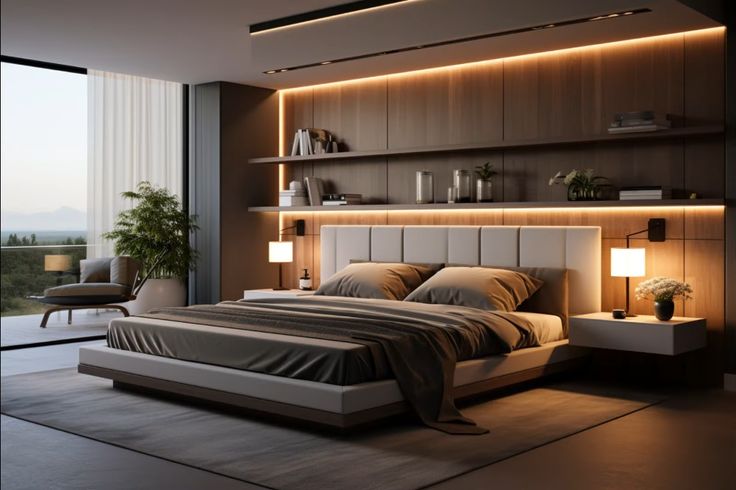The bedroom is arguably the most important part of any home. It’s where we unwind after a long, tiring day and seek solace and relaxation. Yet, despite its significance, many of us don’t give enough thought to planning our bedroom lighting. A lot of people simply install a single tube light and consider the job done, or perhaps they add a few lights in the false ceiling and think that’s all that’s needed. But effective bedroom lighting is far more complex and impactful.
Why Lighting Matters in a Bedroom
Hello everyone, my name is Abhinav Chauhan, and welcome to 91 Ohms, your destination for insightful interior design tips. If you’re passionate about creating the perfect home ambiance, do like and subscribe to the channel. Also, if you’re planning to design your home and need expert help, we are here to guide you. Just head to the description, where you’ll find a link for professional support.
Now, let’s dive into the concept of layered bedroom lighting.
The Concept of Layered Lighting
Ever visited or seen images of a luxurious five-star hotel bedroom? You’ll notice they never rely on a single light source. Instead, there are multiple layers of lighting: cove lights, panel lights, hanging lamps, study lamps, or ambient backlighting around the TV unit. This strategic use of lighting layers creates a warm and inviting atmosphere.
Just as hotel rooms use a layering approach for pillows—large pillows, medium cushions, and smaller throw pillows—layering light sources in your bedroom is a key interior design hack. It enhances the look of the room and creates depth, making the space more dynamic.
How to Create Layers of Light in Your Bedroom
1. The First Layer: Cove Lighting
The first layer is cove lighting, integrated into the false ceiling. It can be designed in various ways to suit your style—pointing inwards, highlighting the walls, or even a unique pattern that complements the room’s overall design. Although we won’t delve into false ceiling design specifics here, the idea is to create a base layer of soft light using a cove.
Types of Lights for Cove Lighting:
- Tube Lights: These were once popular but aren’t recommended anymore because of uneven lighting issues. Tube lights are available in fixed lengths, which may not fit the cove perfectly, leaving dark spots and an unattractive, uneven effect.
- LED Strip Lights: A budget-friendly and flexible option that offers a seamless, even glow. However, they can peel off over time if the adhesive fails, causing lighting gaps.
- Rope Lights: These are durable and provide a seamless look but require skill ful installation. Unlike strip lights, rope lights don’t come with adhesive backing. Electricians may leave them hanging loosely, leading to uneven illumination. Using PVC clips for a secure fit is a smart approach to avoid this issue.
Recommendation: Warm white light is ideal for cove lighting. It creates a soothing, relaxing ambiance, perfect for winding down after a long day.
2. The Second Layer: General Illumination
This is the most crucial layer that brightens up the entire room. Typically, these lights are installed in the false ceiling and can be of two main types: panel lights and COB (chip-on-board) lights.
- Panel Lights: These are versatile and provide a broad spread of light, perfect for general illumination.
- COB Lights: These have a focused beam angle, around 40°, and are great for accent lighting. However, improper placement can create dark patches, so be cautious.
Placement Tips:
- Panel lights should be installed 9-12 inches away from the walls to avoid light blockage and ensure an even glow.
- Keep a distance of 5 feet between panel lights and 3-4 feet for COB lights, based on your design preference.
For a balanced look, use a combination of both light types: panel lights for overall brightness and COB lights for highlighting specific features, like artwork or a reading nook.
3. Calculating the Right Wattage
A common question is, “How many watts should my bedroom lights be?” Here’s a simple thumb rule:
- For a 100 sq. ft. room, you need approximately 70 watts for panel lighting. This can be divided into multiple lights, like seven 10-watt lights or fewer 12-watt lights, depending on your needs.
- If you’re using only COB lights, increase the wattage to 80 watts for adequate illumination.
Remember, this rule is a general guideline. For precise calculations, especially for duplexes, high ceilings, or rooms with numerous windows, consulting a professional is wise.
4. Fine-Tuning the Lighting Experience
To make your lighting more flexible:
- Install dimmers to adjust the brightness based on your mood or activity.
- Divide lights into different switches so that you can choose how many to turn on. For everyday use, two or three switches should suffice, providing 33-60% illumination. When guests are over or during parties, you can turn on all the lights.
5. Choosing the Right Light Color
The final question: Warm white or natural white? Here’s the verdict:
- Warm White: Best for a relaxing, cozy atmosphere.
- Natural White: Works well if you want a balanced and energising feel.
Avoid cool white as it feels harsh and clinical, which is not ideal for a restful bedroom environment.
In conclusion, mastering bedroom lighting involves thoughtful planning and layering. It can transform your space into a luxurious retreat that caters to relaxation and functionality. So, whether you’re designing your bedroom or renovating, keep these tips in mind for a well-lit, beautiful room. Happy designing!

